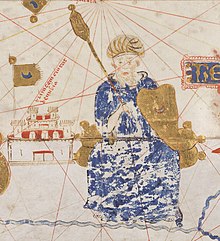Yaghmurasen ibn Zyan
| Yaghmurasen Ibn Zyan يغمراسن إبن زيان | |
|---|---|
| Amîr al-Muslîmîn[1] | |
 Possible depiction of Yaghmurasen | |
| Sultan of the Kingdom of Tlemcen | |
| Reign | 1236–1283 |
| Predecessor | Zyan ben Thabet |
| Successor | Abu Said Uthman I |
| Born | Yaghmurasen Ibn Zyan 1206 |
| Died | February/March 1283[2] (aged 76–77) Miliana (present-day Algeria) |
| Dynasty | Zayyanid |
| Religion | Islam |
Yaghmurasen Ibn Zyan (1206 – February/March 1283, Arabic: يغمراسن إبن زيان, long name: Yaghmurasan ben Ziyan ben Thabet ben Mohamed ben Zegraz ben Tiddugues ben Taaullah ben Ali ben Abd al-Qasem ben Abd al-Wad) was the founder of the Zayyanid dynasty. Under his reign the Zayyanid Kingdom of Tlemcen extended over present-day north-western Algeria.
Life
[edit]He was of the Zenata Berber tribe.[3] He founded the Zayyanid state in 1235, and warred with the Almohad Caliphate until 1248. He was successful in his military campaigns against the Merinids and the Maqil Arab tribe.
The governor of Ceuta, Abou'l-Hassan ben-Khelas, had revolted against the Almohads and recognised the sovereignty of Yaghmurasen, after this the Almohad ruler decided to march against Tlemcen but was defeated by Yaghmurasen.[4] When the Almohad Caliph marched against him, Yaghmurasen defeated him in the Battle of Oujda, the Almohad Caliphs head was taken and ordered to be shown to his mother.[4]
Ibn Khaldun mentions anecdotes about him. Thus Yaghomracen heard genealogists who traced his descent from Muhammad. He commented about this claim in his local Berber language and said this:
If it is true, it will benefit us before God; but, in this world, we will owe our success only to our swords.[5]
When an architect wanted to write his name on a minaret that he had built, Yaghmurasen replied in his Zenati dialect "God knows" (Issen Rebbi).[6]
Name
[edit]In his commentary on the hagiographic book of Ibn al-Zayyat al-Tadili (Attashawof), Ahmed Toufiq explains that Yaghmur in Berber means "the virile/Stallion" whereas the prefix asen means "to them". Thereby giving "Yaghmurasen" a meaning close to "To prevail over them"[7]
See also
[edit]References
[edit]- ^ Abou Zakarya Yah'ya Ibn Khaldoun Trad. Alfred Bel, Histoire des beni 'Abd El-Wad rois de Tlemcen jusqu'au règne d'Abou Hammou Moussa II, Alger, Imprimerie orientale Pierre Fonatana, 1904 p151 ; 152
- ^ a et b Ibn Khaldoun, Histoire des Berbères et des dynasties musulmanes de l'Afrique septentrionale, traduction du baron de Slane (tome III), Ed. Imprimerie du Gouvernement (Alger), 1856 (read online) Archived 2022-03-10 at the Wayback Machine
- ^ The History of Ibn Khaldun, book 7
- ^ a b Histoire des Beni Zeiyan, rois de Tlemcen, par Abou-Abd'Allah-Mohammed ibn-Abd'el-Djelyl et Tenessy, ouvrage trad. par ...' Archived 2024-05-21 at the Wayback Machine Abu Abdallah Muhammad ibn 'Abd-al-jalil al-Tanasi Duprat.
- ^ Khaldoun, Ibn (1856-01-01). Histoire es berbères, 3: et des dynasties musulmanes de l'afrique septentrionale (in French). Translated by William McGuckin de Slane. Imprimerie du Gouvernement. p. 328. Archived from the original on 2022-03-10. Retrieved 2016-09-24.
- ^ Piquet, Victor (1937). Histoire des monuments musulmans du Maghreb (in French). Impr. R. Bauche. Archived from the original on 2022-03-10. Retrieved 2016-09-24.
- ^ Ibn al-Zayyat al-Tadili (1220). التشوف إلى رجال التصوف (in Arabic) (Ahmed Toufiq ed.). p. 286.


 French
French Deutsch
Deutsch